Navigation
Healthy Oceans A Key to Combating Climate Change According to New Rapid Response Report
"Blue Carbon - The Role of Healthy Oceans in Binding Carbon," a new Rapid Response Report released on October 14, 2009 estimates that carbon emissions equal to half the annual emissions of the global transport sector are being captured and stored by marine ecosystems such as mangroves, salt marshes and seagrasses.
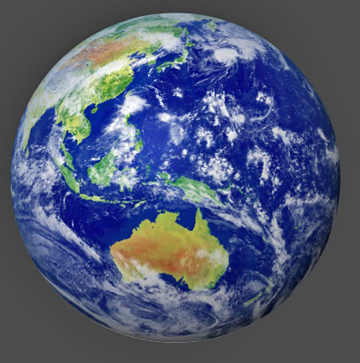 |
| “Out of all the biological carbon captured in the world, over half is captured by marine living organisms hence it is called blue carbon.” iStockphoto/Jan Rysavy |
"Blue Carbon - The Role of Healthy Oceans in Binding Carbon," a new Rapid Response Report released on October 14, 2009 estimates that carbon emissions equal to half the annual emissions of the global transport sector are being captured and stored by marine ecosystems such as mangroves, salt marshes and seagrasses.
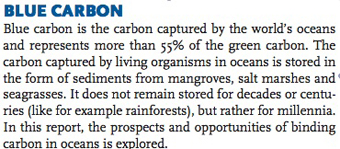 |
The Report calls upon governments keen to combat climate change to consider a 'Blue Carbon' fund to invest in the maintenance and rehabilitation of key marine ecosystems.
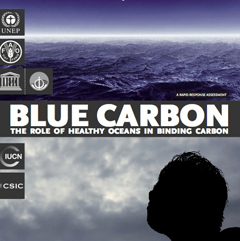 |
The Blue Carbon report, compiled by the United Nations Environment Programme (UNEP) in collaboration with the Food and Agricultural Organization (FAO) and the United Nations Educational, Scientific and Cultural Organization (UNESCO), and leading scientists, puts some hard figures on the carbon capturing potential of the marine environment and on the impact of marine degradation on climate change.
It also outlines the way markets might begin paying developing countries for conserving and enhancing the marine environment's carbon capture and storage services (CCS) and the links between healthy oceans and adaptation to climate change.
Currently, several developed countries are considering spending billions of dollar on CCS at power stations while the CCS services of natural systems, such as the seas and oceans, are tested and probably more cost effective.
A combination of reducing deforestation on land, allied to restoring the coverage and health of these marine ecosystems could deliver up to 25% of the emissions reductions needed to avoid 'dangerous' climate change.
But the report warns that far from maintaining and enhancing these natural carbon sinks humanity is damaging and degrading them at an accelerating rate.
It estimates that up to seven percent of these 'blue carbon sinks' are being lost annually, or seven times the rate of loss of 50 years ago.
"If more action is not taken to sustain these vital ecosystems, most may be lost within two decades," says the Report.
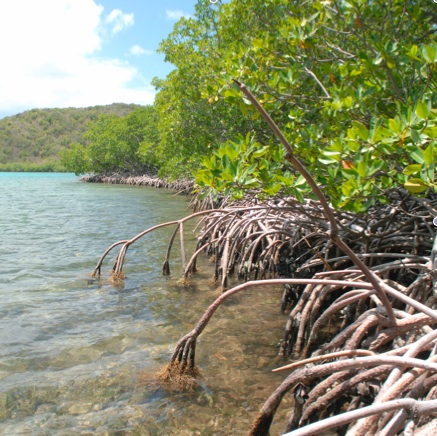 |
| Mangroves. Blue Carbon Sinks: One key function of vegetated coastal habitats is their role as carbon sinks. Benefiting from the excellent conditions available to support plant growth, vegetated coastal habitats rank amongst the most productive habitats in the world, comparable in production to the most productive agricultural crops… Photo: iStockphoto/Susanna Pershern |
Achim Steiner, UN Under-Secretary General and UNEP Executive Director, said: "We already know that marine ecosystems are multi-trillion dollar assets linked to sectors such as tourism, coastal defense, fisheries and water purification services-now it is emerging that they are natural allies against climate change. "Indeed this report estimates that halting losses and catalyzing the recovery of marine ecosystems might contribute to offsetting up to seven percent of current fossil fuel emissions and at a fraction of the costs of technologies to capture and store carbon at power stations," he added.
The new report comes on October 14, 2009, less than 60 days before the crucial UN climate change convention meeting in Copenhagen where governments need to Seal the Deal on a comprehensive new agreement.
It is likely that nations will agree to pay developing economies to maintain the 'green carbon' in forests under a partnership-Reduced Emissions from Deforestation and Forest Degradation (REDD).
Mr Steiner added: "The links between deforestation and climate change are firmly on the political radar and there is optimism that REDD will form part of a new global climate partnership, but the role and the opportunity presented by other ecosystems are still overlooked. If the world is to decisively deal with climate change, every source of emissions and every option for reducing these should be scientifically evaluated and brought to the international community's attention-that should include all the colours of carbon including now blue carbon linked with the seas and oceans."
Dr. Carlos Duarte, one of the chief scientists of the report based at the Mediterranean Institute of Advanced Studies in Spain, said: "We know that land use change is part of the climate change challenge. Perhaps less well known is that the global loss of what we could call our ‘blue carbon sinks,’ such as mangroves and seagrasses, are actually among the key components of the increase in greenhouse concentrations from all land use changes."
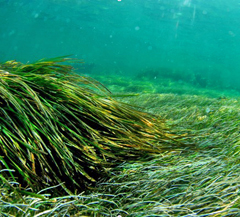 |
| Seagrasses Photo: OCEANA/Juan Cuetos |
Christian Nellemann, Editor of the Rapid Response report, said: "There is an urgency to act now to maintain and enhance these carbon sinks - since the 1940s, over 30% of mangroves; close to 25% of salt marshes and over 30% of seagrass meadows have been lost. We are losing these crucial ecosystems much faster than rainforests and at the very time we need them - on current trends they may be all largely lost within a couple of decades."
"Fishing and aquaculture communities will be heavily impacted by climate change and have a key role to play in maintaining healthy ocean ecosystems in the face of change," said Ichiro Nomura, Assistant Director-General for Fisheries and Aquaculture at FAO. "An ecosystem approach to the management of ocean and coastal areas cannot only enhance their natural carbon sink capacity, but also offers a way to safeguard and strengthen food and livelihood security for fisheries-dependent communities," he added.
Officials with UNESCO also underlined the important role the oceans are already playing in offsetting climate change and its impacts on humanity, but warn that this is having consequences too.
"Because the ocean has already absorbed 82% of the total additional energy accumulated in the planet due to global warming, it is fair to say that the ocean has already spared us from dangerous climate change," says Patricio Bernal, Assistant Director-General of UNESCO, IOC Executive Secretary. "But each day we are essentially dumping 25 million tons of carbon into the ocean. As a consequence, the ocean is turning more acidic, posing a huge threat to organisms with calcareous structures."
Luciano Fonseca of UNESCO-IOC explains that the ocean's absorption of the planet's excess heat "is like a glass of whisky with ice. As long as the ice is there the whisky stays cool. The energy that is going into the glass, from your hand and room temperature, is working to convert the ice to liquid. As soon as the ice melts the whisky turns warm."
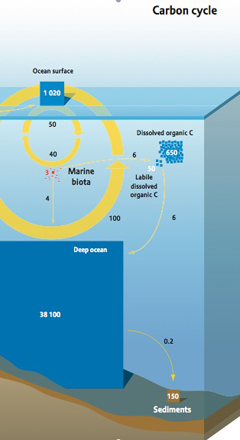 |
| Carbon Cycle |
 |
Key Findings from the Rapid Assessment Report
- Of all the biological carbon, or green carbon captured in the world, over half (55%) is captured by marine-living organisms - not on land - hence the new term blue carbon.
- Marine-living organisms range from plankton and bacteria to seagrasses, saltmarsh plants and mangrove forests.
- The ocean's vegetative habitats, in particular, mangroves, salt marshes and seagrasses, cover less than 1% of the seabed.
- These form the planet's blue carbon sinks and account for over half of all carbon storage in ocean sediment and perhaps as much as over 70%.
- They comprise only 0.05% of the plant biomass on land, but store a comparable amount of carbon per year, and thus rank among the most intense carbon sinks on the planet.
- Blue carbon sinks and estuaries capture and store between 235-450 Teragrams (Tg C) or 870 to 1,650 million tons of CO2 every year - or the equivalent of up to near half of the emissions from the entire global transport sector which is estimated annually at around 1,000 Tg C, or around 3,700 million tons of CO2, and rising.
- Preventing the further loss and degradation of these ecosystems and catalyzing their recovery can contribute to offsetting 3-7% of current fossil fuel emissions (totaling 7,200 Tg C a year or around 27,000 million tons) of CO2 in two decades - over half of that projected for reducing rainforest deforestation.
- The effect would be equivalent to at least 10% of the reductions needed to keep concentrations of CO2 in the atmosphere below 450 ppm needed to keep global warming below two degrees Celsius.
- Combined with action under REDD, halting the degradation and restoring lost marine ecosystems might deliver up to 25% of emission reductions needed to keep global warming below two degrees Celsius.
- Unlike carbon capture and storage on land, where the carbon may be locked away for decades or centuries, that stored in the oceans remains for millennia.
Currently, on average, between 2-7% of our blue carbon sinks are lost annually, a seven-fold increase compared to only half a century ago.
- In parts of Southeast Asia losses of mangroves since the 1940s are as high as 90%.
- Large-scale restoration of mangroves has been successfully achieved in Vietnam's Mekong Delta and salt-marsh restoration in Europe and the United States.
Countries with extensive, shallow coastal areas that could consider enhancing marine carbon sinks include India; many countries in southeast Asia; those on the Black Sea; in West Africa, the Caribbean, the Mediterranean, eastern United States and Russia.
Maintaining and Recovering Marine Ecosystems-the Wider Benefits
Coastal waters account for just seven percent of the total area of the ocean. However, the productivity of ecosystems such as coral reefs, and these blue carbon sinks mean that this small area forms the basis of the world's primary fishing grounds, supplying an estimated 50% of the world's fisheries.
They provide vital nutrition for close to three billion people, as well as 50% of animal protein and minerals to 400 million people of the least developed countries in the world.
The coastal zones, of which these blue carbon sinks are central for productivity, deliver a wide range of benefits to human society. These include filtering water, reducing effects of coastal pollution, nutrient loading, and sedimentation, protecting the coast from erosion, and buffering the effects of extreme weather events.
- Coastal ecosystem services have been estimated to be worth over US$25,000 billion annually, ranking among the most economically valuable of all ecosystems.
- Much of the degradation of these ecosystems not only comes from unsustainable natural resource use practices, but also from poor watershed management, poor coastal development practices and poor waste management.
- The protection and restoration of coastal zones, through coordinated integrated management would also have significant and multiple benefits for health, labour productivity and food security of communities in these areas.
Notes:
The full Blue Carbon Report is available at http://www.unep.org/ and at http://www.grida.no/.
The Blue Carbon report compliments a report launched by UNEP on the occasion of World Environment Day 2009 called The Natural Fix?-The Role of Ecosystems in Climate Mitigation http://www.unep.org/pdf/BioseqRRA_scr.pdf
The content of this article is from a UNEP release of October 14, 2009.
All images are from the Blue Carbon Report. Individual photographers are credited as listed in the Report.
Search
Latest articles
Agriculture
- World Water Week: Healthy ecosystems essential to human health: from coronavirus to malnutrition Online session Wednesday 24 August 17:00-18:20
- World Water Week: Healthy ecosystems essential to human health: from coronavirus to malnutrition Online session Wednesday 24 August 17:00-18:20
Air Pollution
- "Water and Sanitation-Related Diseases and the Changing Environment: Challenges, Interventions, and Preventive Measures" Volume 2 Is Now Available
- Global Innovation Exchange Co-Created by Horizon International, USAID, Bill and Melinda Gates Foundation and Others
Biodiversity
- It is time for international mobilization against climate change
- World Water Week: Healthy ecosystems essential to human health: from coronavirus to malnutrition Online session Wednesday 24 August 17:00-18:20
Desertification
- World Water Week: Healthy ecosystems essential to human health: from coronavirus to malnutrition Online session Wednesday 24 August 17:00-18:20
- UN Food Systems Summit Receives Over 1,200 Ideas to Help Meet Sustainable Development Goals
Endangered Species
- Mangrove Action Project Collaborates to Restore and Preserve Mangrove Ecosystems
- Coral Research in Palau offers a “Glimmer of Hope”
Energy
- Global Innovation Exchange Co-Created by Horizon International, USAID, Bill and Melinda Gates Foundation and Others
- Wildlife Preservation in Southeast Nova Scotia
Exhibits
- Global Innovation Exchange Co-Created by Horizon International, USAID, Bill and Melinda Gates Foundation and Others
- Coral Reefs
Forests
- NASA Satellites Reveal Major Shifts in Global Freshwater Updated June 2020
- Global Innovation Exchange Co-Created by Horizon International, USAID, Bill and Melinda Gates Foundation and Others
Global Climate Change
- It is time for international mobilization against climate change
- It is time for international mobilization against climate change
Global Health
- World Water Week: Healthy ecosystems essential to human health: from coronavirus to malnutrition Online session Wednesday 24 August 17:00-18:20
- More than 400 schoolgirls, family and teachers rescued from Afghanistan by small coalition
Industry
- "Water and Sanitation-Related Diseases and the Changing Environment: Challenges, Interventions, and Preventive Measures" Volume 2 Is Now Available
- Global Innovation Exchange Co-Created by Horizon International, USAID, Bill and Melinda Gates Foundation and Others
Natural Disaster Relief
- STOP ATTACKS ON HEALTH CARE IN UKRAINE
- Global Innovation Exchange Co-Created by Horizon International, USAID, Bill and Melinda Gates Foundation and Others
News and Special Reports
- World Water Week: Healthy ecosystems essential to human health: from coronavirus to malnutrition Online session Wednesday 24 August 17:00-18:20
- STOP ATTACKS ON HEALTH CARE IN UKRAINE
Oceans, Coral Reefs
- World Water Week: Healthy ecosystems essential to human health: from coronavirus to malnutrition Online session Wednesday 24 August 17:00-18:20
- Mangrove Action Project Collaborates to Restore and Preserve Mangrove Ecosystems
Pollution
- Zakaria Ouedraogo of Burkina Faso Produces Film “Nzoue Fiyen: Water Not Drinkable”
- "Water and Sanitation-Related Diseases and the Changing Environment: Challenges, Interventions, and Preventive Measures" Volume 2 Is Now Available
Population
- "Water and Sanitation-Related Diseases and the Changing Environment: Challenges, Interventions, and Preventive Measures" Volume 2 Is Now Available
- "Water and Sanitation-Related Diseases and the Changing Environment: Challenges, Interventions, and Preventive Measures" Volume 2 Is Now Available
Public Health
- Honouring the visionary behind India’s sanitation revolution
- Honouring the visionary behind India’s sanitation revolution
Rivers
- World Water Week: Healthy ecosystems essential to human health: from coronavirus to malnutrition Online session Wednesday 24 August 17:00-18:20
- Mangrove Action Project Collaborates to Restore and Preserve Mangrove Ecosystems
Sanitation
- Honouring the visionary behind India’s sanitation revolution
- Honouring the visionary behind India’s sanitation revolution
Toxic Chemicals
- "Water and Sanitation-Related Diseases and the Changing Environment: Challenges, Interventions, and Preventive Measures" Volume 2 Is Now Available
- Actions to Prevent Polluted Drinking Water in the United States
Transportation
- "Water and Sanitation-Related Diseases and the Changing Environment: Challenges, Interventions, and Preventive Measures" Volume 2 Is Now Available
- Urbanization Provides Opportunities for Transition to a Green Economy, Says New Report
Waste Management
- Honouring the visionary behind India’s sanitation revolution
- Honouring the visionary behind India’s sanitation revolution
Water
- Honouring the visionary behind India’s sanitation revolution
- Honouring the visionary behind India’s sanitation revolution
Water and Sanitation
- Honouring the visionary behind India’s sanitation revolution
- Honouring the visionary behind India’s sanitation revolution

